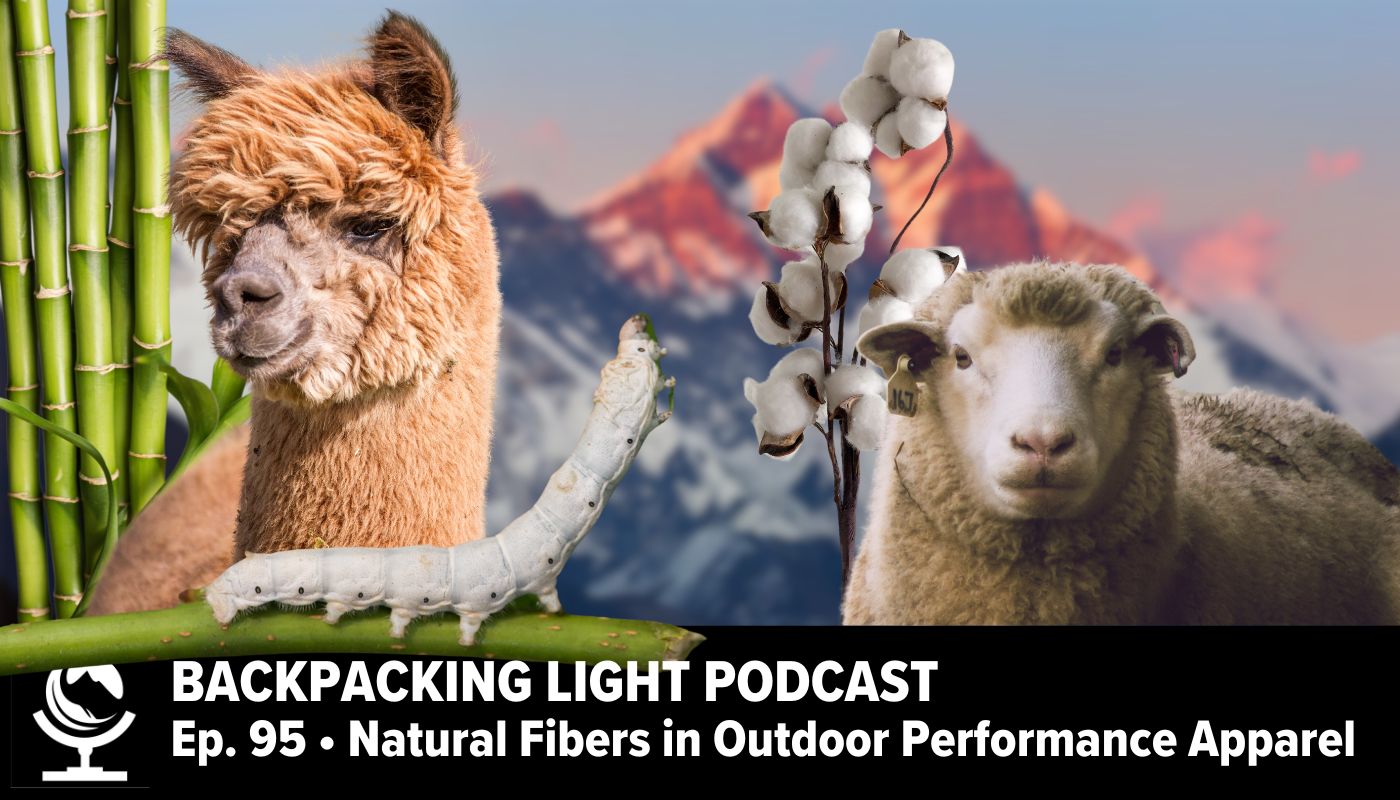Podcast 95 | Natural Fibers in Outdoor Performance Apparel
Episode Summary
In episode 95 of the Backpacking Light podcast we're going to learn about the types of natural fibers that make up the fabrics we use for base layer and insulating apparel.
Episode Sponsor
This episode of the backpacking light podcast is sponsored by ARMS OF ANDES, manufacturer of premium base layer apparel made with alpaca wool. Backpacking Light podcast listeners can enjoy 15% off with the coupon code ALPACALIGHT at armsofandes.com.
Listen
Summary
In episode 95 of the Backpacking Light podcast we’re going to learn about the types of natural fibers that make up the fabrics we use for base layer and insulating apparel.

In this Episode:
What’s New at Backpacking Light?
- Check out our education offerings and special events on the brand-new Backpacking Light Calendar.
- Member Q&A – January 11, 2024
- BPL Basecamp Spring ’24 Cohort – beginning January 31st!
Featured Gear: Comparing the XTherm NXT and Nemo Tensor Extreme
| Therm-a-Rest NeoAir XTherm NXT | NEMO Tensor Extreme Conditions | |
|---|---|---|
| Size Standard - Reg Wide | Mummy | Rectangular |
| thickness | 3 in (7.6 cm) | 3.5 in (8.9 cm) |
| weight | 19 oz (255 g) | 22 oz (624 g) |
| packed size | 5 x 11 in (12.7 x 27.9 cm) | 4.5 x 10.5 in (11.4 x 26.7 cm) |
| top fabric | 30d nylon | 20d nylon |
| bottom fabric | 70d nylon | 20d nylon |
| cost | $259.95 | $259.95 |
| R | 7.3 | 8.5 |
| insulation | aluminized film | aluminized film |
| noise | noisy | quiet |
| warmth | "warmer?" | ? |
| stability | horizontal baffles | pseudo-square baffles |
| insulation construction | triangular baffles made with reflective surfaces (isolate air movement) | horizontal aluminized surfaces that allow for convective air movement up and down the length of the pad |
Main Topic: Fundamentals of Natural Fibers
- The primary differences between natural fibers and synthetic fibers – source, moisture management, thermal properties, durability, comfort and feel, odor resistance, environmental impact, care and maintenance, cost
- New research on aerogel fabrics
- Types of natural fibers:
- Plant-based fibers – cotton, linen / flax, hemp, jute, bamboo, sisal
- Animal-based fibers – wool, silk, cashmere, mohair, alpaca, mohair, angora
- Mineral-based fibers – asbestos
- Comparing the structure of plant-based and animal-based fibers – cellulose vs protein structures, microscopic structure, absorbency vs thermal properties
- Unique characteristics of wool fibers – crimp, keratin-based, hygroscopic nature, thermal insulation, odor resistance, flame resistance, biodegradability, felting, dyeability, elasticity and comfort
- Merino Sheep Wool vs Other Kinds of Wool – fiber diameter and fineness, crimp, strength and durability, comfort and feel, breathability and moisture management, odor resistance, price, and availability
- Merino sheep wool vs Alpaca Wool – fiber texture and softness, warmth and insulation, weight, moisture wicking and breathability, hypoallergenic properties, durability and elasticity, odor resistance, price and availability, environmental impact
- Comparing and Contrasting Huacaya Alpaca Wool and Suri Alpaca Wool
Q&A
- What’s the best baselayer that works with a waterproof-nonbreathable jacket like those from Lightheart Gear and Antigravity Gear?
- What’s the difference between fishnet baselayers from Brynje and those from Wiggy’s and others?
- Can fishnet be used in warmer temperatures?
Submit a Tip, Trick, or Question
Share your tips, tricks, and questions on the podcast – submit it via email to [email protected].
Links, Mentions, and Related Content
- Gear Testing and Research: By the Numbers: What’s the Best Base Layer Fabric? Wool vs. Alpaca vs. Polyester
- Gear Testing and Research: Why is my Baselayer Soaked?
- Gear Testing and Research: Air permeability vs. moisture vapor transmission rate (MVTR): which one impacts moisture transport more in wind and rain jackets?
- Podcast: Episode 90 | Alpaca Wool Baselayers
Go Deeper with Backpacking Light
- Sign up for the Newsletter.
- Become a Backpacking Light Member.
- Follow us elsewhere on the web: YouTube | Instagram | Facebook
How to Subscribe
- Apple Podcasts | Spotify | RSS
More Episodes
Credits
- Executive Producer - Backpacking Light; Show Director and Host - Ryan Jordan; Producer - Chase Jordan; Theme music: Look for Me in the Mountains written by Chris Cunningham and Ryan Jordan, performed by Chris Cunningham (acoustic guitar, lead and harmony vocals, harmonica), Chad Langford (upright bass), and Tom Murphy (mandolin), produced by Basecamp Studios in Bozeman, Montana.
Feedback / Tips / Questions
More Backpacking Light
- Sign up for the Newsletter.
- Become a Backpacking Light Member.
- Follow us elsewhere on the web: YouTube | Instagram | Facebook
Disclosure
- Sponsorship Policy: Backpacking Light does not accept compensation or donated/discounted products in exchange for product mentions or placements in editorial coverage, including any podcast episode content not excplicitly identified as sponsored content.
- Some (but not all) of the links in these show notes may be affiliate links. If you click on one of these links and visit one of our affiliate partners (usually a retailer site), and subsequently place an order with that retailer, we receive a commission on your entire order, which varies between 3% and 15% of the purchase price. Affiliate commissions represent less than 15% of Backpacking Light's gross revenue. More than 70% of our revenue comes from Membership Fees. So if you'd really like to support our work, don't buy gear you don't need - support our consumer advocacy work and become a Member instead.
- Learn more about affiliate commissions, influencer marketing, and our consumer advocacy work by reading our article Stop wasting money on gear.





Home › Forums › Podcast 95 | Natural Fibers in Outdoor Performance Apparel